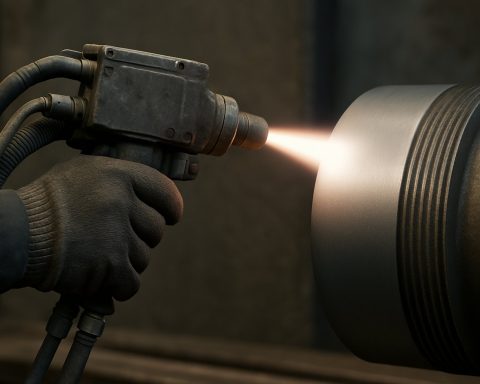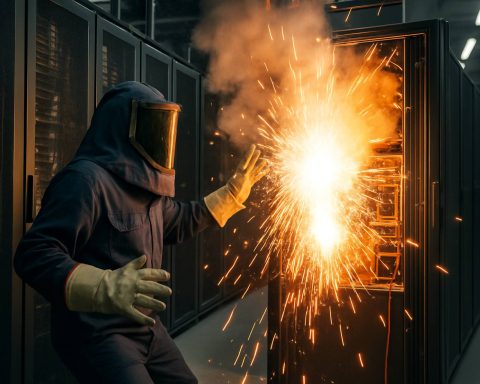- Stock markets mimic storms: unpredictable with tech companies often caught in the winds.
- SoundHound AI surged when Nvidia acquired a stake but later plummeted 61% after Nvidia’s divestment.
- Nvidia’s exit left investors speculating on future collaborations, clouding SoundHound’s vision of a voice AI ecosystem.
- Revenue grew 101% year-over-year, yet non-organic expansion threatens stability and financial health.
- Challenging figures: Gross margins fell to 39.9%, operating losses surged nearly 2,000% to $257 million.
- Efforts in integrating voice AI and generative algorithms show promise, especially in quick-service restaurant automation.
- The voice AI field will evolve, but SoundHound’s financial instability suggests continued stock turbulence.
- SoundHound’s journey underscores the need for monetary prudence alongside innovation in tech markets.
Stock markets often function like storms—sudden, powerful, and unpredictable. Newly sprouted tech companies might momentarily capture the lightning, only to soon find themselves tossed aside by the gales of reality.
SoundHound AI epitomized this phenomenon, briefly soaring on hype winds after tech titan Nvidia acquired a modest stake. Enthusiasts latched onto Nvidia’s interest as a beacon of prosperity, propelling SoundHound’s shares to a vertiginous high of $24.98. Fast forward a year, and the allure dulled; shares sank 61%, leaving investors grappling with whether to seize this discounted opportunity or watch from a cautious distance.
The unraveling began quietly. Nvidia, a powerhouse in AI chip production, discreetly untangled its stake in SoundHound by February 2025. The revelation of Nvidia’s complete divestment, a profoundly strategic decision, sent investors and analysts into a frenzy, speculating the underlying causes of such a swift exit. Nvidia’s departure signaled no immediate plans for future collaborations, casting a shadow over SoundHound’s ambitious vision of evolving into a holistic voice AI ecosystem.
For the uninitiated, such tech investments often depict shadowy motives. Nvidia’s initial stake wasn’t just a mark of assured returns; it reflected an industry colossus fostering the growth of AI applications that could later fuel its chip sales. An indirect nod of approval, perhaps, rather than an ironclad vote of confidence in SoundHound’s longevity.
As investors grew distracted by Nvidia’s stake, the company’s fundamental health often receded from scrutiny. SoundHound’s revenue painted a picture of rapid expansion—a 101% year-over-year surge to $34.5 million in the fourth quarter. Yet, beneath this facade of growth lurked the complexities of burgeoning acquisitions, such as the high-profile purchases of enterprise AI firm Amelia and the online food platform, Allset. Such non-organic growth might not replicate itself quarterly, thus posing a threat to future stability.
This spree also ignited financial strain—gross margins nosedived from 77.2% to 39.9%, while operating losses catastrophically ballooned to $257 million, expanding nearly 2,000%. Such figures illuminate the challenges faced by companies attempting to mesh disparate branches of voice recognition and AI into a unified force.
SoundHound isn’t merely resting idle, though. Its efforts to integrate voice AI with generative algorithms show promise, particularly in automating quick-service restaurant drive-thrus. Here lies a burgeoning industry craving efficiency, where SoundHound lays claims of collaborations with a significant slice of the top quick-service brands. Yet whether these companies bank on full integration remains shrouded in mystery.
The landscape of voice AI is set to evolve markedly within the coming years, yet SoundHound’s financial tempest signals a likely continuation of stock strife unless fiscal discipline reigns and profitability pathways cement. Investors must weigh the allure of potential innovation against the whirlwinds of operational losses—a classic case of assessing whether the storm will calmly pass or intensify.
In the end, SoundHound’s narrative serves as a vibrant reminder: Tech markets thrive on narratives and momentum, yet sustaining success demands an often-overlooked foundation of monetary prudence and strategic clarity.
SoundHound AI: Navigating the Storms of the AI Market
Overview: The Rise and Fall of SoundHound AI
The stock market is often likened to a storm—unpredictable and volatile. SoundHound AI, a promising player in the tech industry, experienced this firsthand. Once hailed as a lucrative opportunity, its shares skyrocketed to $24.98 following Nvidia’s investment. However, within a year, this optimism faded, with shares plummeting by 61%. Nvidia’s swift exit in February 2025 left analysts and investors puzzled, emphasizing the precarious nature of tech investments. This article dives into SoundHound’s situation, exploring markets, opportunities, risks, and future predictions.
Industry Insights and Market Trends
– Voice AI Landscape: As the demand for AI-driven solutions grows, the voice AI industry remains robust. SoundHound is leveraging this trend by focusing on quick-service restaurant integrations—an area expected to expand as companies seek efficiency. For broader perspective, research from Gartner indicates a compound annual growth rate (CAGR) of 16% for voice AI applications through 2030.
– Tech Collaboration Dynamics: Nvidia’s initial involvement reflects a broader strategy where tech giants back promising firms to foster the ecosystem surrounding their main business—in Nvidia’s case, its AI chip sales. The exit suggests competitive pressures or strategic realignments rather than a verdict on SoundHound’s potential.
Financial Analysis
– Revenue vs. Growth: SoundHound’s 101% year-over-year revenue surge to $34.5 million paints a picture of expansion. However, the acquisitions of companies like Amelia and Allset add complexity. Non-organic growth strategies are risky, potentially unsustainable if not integrated efficiently.
– Financial Strain and Risks: The drastic drop in gross margins (from 77.2% to 39.9%) and ballooned operating losses ($257 million) indicate financial strain. Sustained losses pose significant risks, stressing the need for a tighter fiscal strategy to ensure long-term viability.
Opportunities and Use Cases
– Quick-Service Restaurant Integration: SoundHound is making strides in automating drive-thrus with voice AI. This innovation could lead to labor cost savings and faster service. McKinsey & Company highlight that automation in the food service industry could lead to a 20-30% increase in productivity.
Expert Opinions and Predictions
– AI Market Growth: Experts predict the AI market to exceed $500 billion by 2025, driven by advancements in machine learning and AI applications (Source: Forrester). SoundHound’s positioning in this market could yield dividends if navigated wisely.
– SoundHound’s Path Forward: For SoundHound to stay competitive, experts recommend a dual approach: enhance core technologies while maintaining fiscal discipline. Sustainability depends on cutting operational excess and ensuring product-market fit beyond hype-driven investments.
Actionable Recommendations
1. Strategic Alliances: Forge technology partnerships to co-develop AI innovations, enhancing product appeal.
2. Focus on Core Competencies: Prioritize development in areas with tangible ROI, like quick-service integrations.
3. Invest in Financial Resilience: Balance expansion with cost control, aiming for profitability within key business units.
4. Incorporate Customer Feedback: Iteratively update products based on end-user input to refine offerings and capture market share.
Conclusion
SoundHound AI’s journey is emblematic of the tech industry’s propensity for both rapid ascensions and dramatic declines. Key for SoundHound will be finding its footing amidst volatility by leveraging industry trends, financial acumen, and strategic clarity. Potential investors and stakeholders should closely watch fiscal performance and innovation pathways before making engagements.
For more insights on AI trends and market dynamics, visit TechCrunch and CB Insights.











